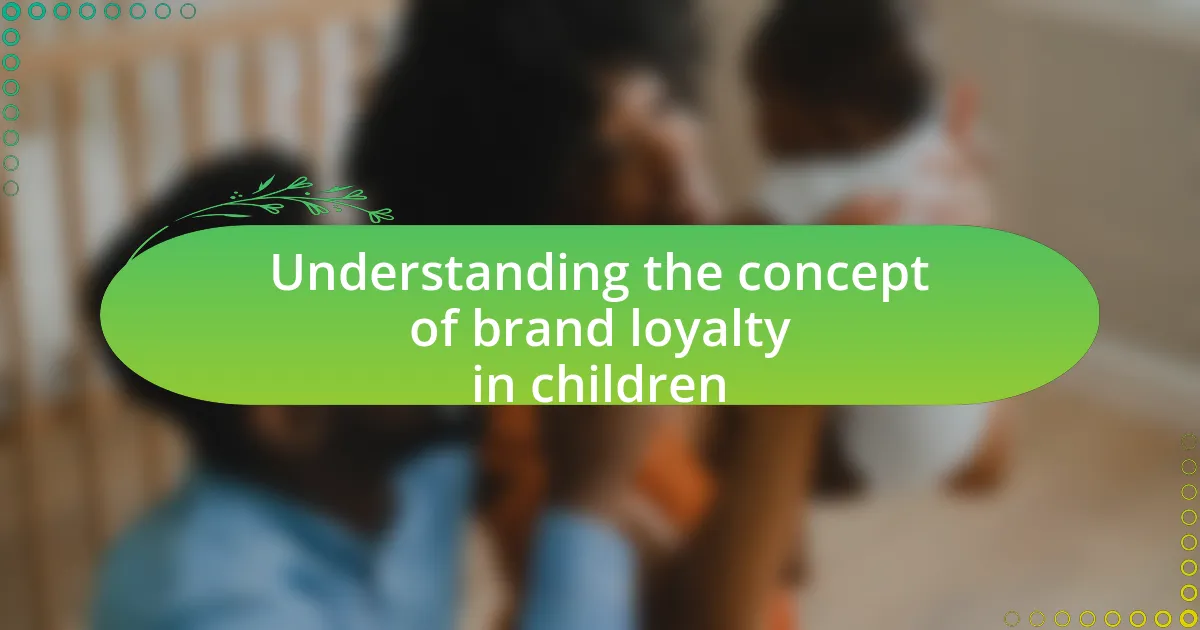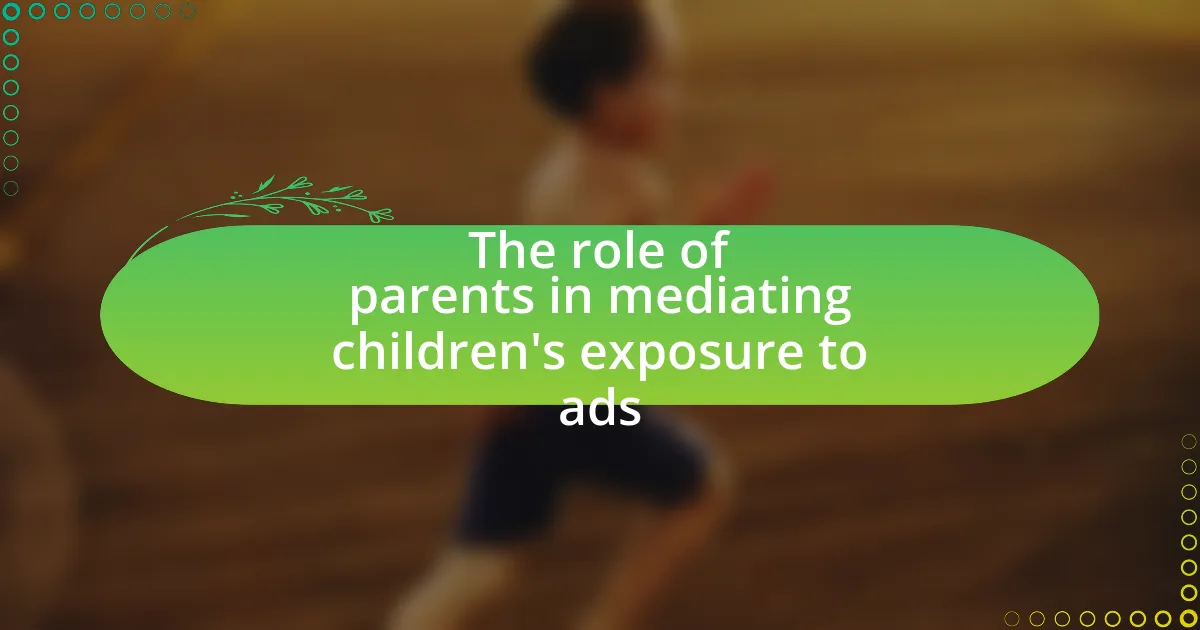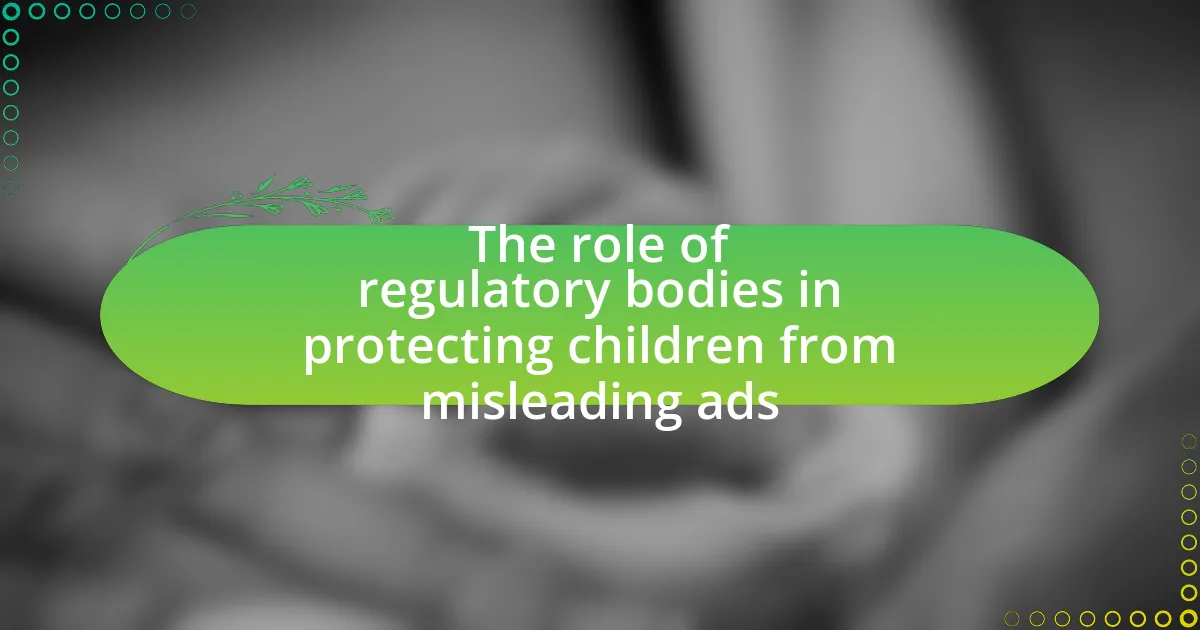The article examines the effects of targeted advertising on children’s self-esteem, highlighting how exposure to idealized images and materialistic messages can lead to feelings of inadequacy and lower self-worth. Research indicates that children, particularly those aged 8 to 12, are especially vulnerable to these influences, which can result in body dissatisfaction and mental health issues. The article discusses the role of parental guidance in mediating these effects, the importance of media literacy education, and potential regulatory measures to protect children from harmful advertising practices. Additionally, it explores the long-term consequences of early exposure to targeted advertising on adult self-esteem and societal beauty standards.
What are the effects of targeted advertising on children’s self-esteem?
Targeted advertising negatively affects children’s self-esteem by promoting unrealistic standards and materialism. Research indicates that children exposed to targeted ads often develop feelings of inadequacy when they cannot meet the idealized images presented, leading to lower self-worth. A study published in the Journal of Consumer Research found that children who frequently encounter advertisements tailored to their interests are more likely to experience body dissatisfaction and a desire for products that promise social acceptance. This correlation highlights the detrimental impact of targeted marketing on young individuals’ self-perception and emotional well-being.
How does targeted advertising influence children’s perceptions of themselves?
Targeted advertising significantly influences children’s perceptions of themselves by shaping their self-image and self-worth based on marketed ideals. Research indicates that children exposed to advertisements featuring idealized body types and lifestyles often develop unrealistic standards for themselves, leading to feelings of inadequacy. A study published in the journal “Pediatrics” found that children who frequently view advertisements are more likely to express dissatisfaction with their bodies and lower self-esteem. This correlation suggests that targeted advertising not only affects children’s immediate desires for products but also has long-term implications on their self-perception and mental health.
What specific messages in targeted advertising impact children’s self-image?
Targeted advertising impacts children’s self-image through messages that emphasize idealized beauty, material success, and social acceptance. These advertisements often portray unattainable standards, suggesting that happiness and popularity are linked to specific products or lifestyles. For instance, research by the American Psychological Association indicates that exposure to such advertisements can lead to body dissatisfaction and lower self-esteem among children, particularly girls, who are frequently targeted with beauty and fashion ads. Additionally, studies show that advertisements promoting luxury items can create a sense of inadequacy in children who feel they do not measure up to their peers, further affecting their self-worth.
How do children’s developmental stages affect their response to targeted advertising?
Children’s developmental stages significantly influence their response to targeted advertising, as cognitive and emotional maturity affects their understanding and interpretation of marketing messages. Younger children, typically in the preoperational stage (ages 2-7), often lack the critical thinking skills necessary to discern persuasive intent, making them more susceptible to advertisements that appeal to emotions or desires. In contrast, older children in the concrete operational stage (ages 7-11) begin to develop analytical skills, allowing them to recognize advertising tactics but still may not fully grasp the implications of consumerism. Research indicates that children aged 8-12 are particularly vulnerable to targeted advertising, as they are developing their self-concept and are influenced by peer perceptions, which can impact their self-esteem. Studies show that exposure to idealized images in advertisements can lead to negative self-perception among children, particularly girls, as they compare themselves to unrealistic standards presented in media.
Why is children’s self-esteem particularly vulnerable to advertising?
Children’s self-esteem is particularly vulnerable to advertising because they are in a developmental stage where they are highly impressionable and lack the critical thinking skills necessary to evaluate marketing messages. Research indicates that children, typically aged 8 to 12, are more susceptible to advertising due to their cognitive and emotional development, which makes them more likely to internalize the ideals presented in ads. For instance, a study published in the Journal of Advertising Research found that children exposed to idealized images in advertisements often experience a decrease in self-worth and body image satisfaction. This vulnerability is exacerbated by the pervasive nature of advertising across various media platforms, leading to constant comparisons with unrealistic standards.
What psychological factors contribute to children’s susceptibility to advertising messages?
Children’s susceptibility to advertising messages is significantly influenced by cognitive development, emotional factors, and social influences. Cognitive development plays a crucial role, as children under the age of eight often lack the ability to critically evaluate advertising content, making them more impressionable. Emotional factors, such as the desire for acceptance and belonging, drive children to respond positively to advertisements that depict social approval or popularity. Additionally, social influences, including peer pressure and parental attitudes towards advertising, further enhance children’s receptiveness to marketing messages. Research indicates that children are particularly vulnerable to persuasive techniques used in advertising, such as the use of cartoon characters and catchy jingles, which can create strong associations between products and positive emotions.
How does peer influence amplify the effects of targeted advertising on self-esteem?
Peer influence significantly amplifies the effects of targeted advertising on self-esteem by creating social validation for the products being advertised. When peers endorse or discuss specific brands or products, children are more likely to internalize these messages, leading to increased pressure to conform to perceived social norms. Research indicates that adolescents are particularly susceptible to peer influence, as their self-esteem is closely tied to social acceptance and identity formation. For instance, a study published in the Journal of Advertising Research found that adolescents exposed to peer-endorsed advertisements reported higher levels of brand preference and self-esteem compared to those who were not influenced by peers. This demonstrates that the combination of targeted advertising and peer validation can create a feedback loop, where children’s self-esteem is further affected by their desire to align with their peers’ preferences.
What role do parents play in mediating the effects of targeted advertising?
Parents play a crucial role in mediating the effects of targeted advertising on children by guiding their understanding and interpretation of marketing messages. They can influence children’s perceptions of advertisements through discussions about the intent behind marketing, helping them develop critical thinking skills regarding consumerism. Research indicates that parental involvement, such as co-viewing advertisements and discussing their content, can reduce the negative impact of targeted advertising on children’s self-esteem by fostering resilience and promoting media literacy. For instance, a study published in the Journal of Advertising Research found that children who engaged in discussions about advertisements with their parents exhibited a greater ability to discern persuasive intent, leading to healthier self-esteem outcomes.
How can parental guidance mitigate negative impacts on children’s self-esteem?
Parental guidance can mitigate negative impacts on children’s self-esteem by fostering open communication and providing emotional support. When parents engage in discussions about targeted advertising, they can help children critically analyze the messages they receive, which empowers them to develop a healthier self-image. Research indicates that children who receive guidance from parents are better equipped to resist unrealistic standards set by advertisements, leading to improved self-esteem. For instance, a study published in the Journal of Adolescent Research found that parental involvement significantly correlates with higher self-esteem levels in children, as it helps them navigate social pressures and media influences effectively.
What strategies can parents use to discuss advertising messages with their children?
Parents can use several strategies to discuss advertising messages with their children, including encouraging critical thinking, using real-life examples, and fostering open communication. Encouraging critical thinking involves asking children questions about advertisements, such as what they think the ad is trying to sell and whether they believe the claims made are true. Using real-life examples helps children relate to the content; for instance, parents can point out ads during TV shows or online and discuss their persuasive techniques. Fostering open communication allows children to express their thoughts and feelings about advertisements, which can help them understand the impact of these messages on their self-esteem and body image. Research indicates that children who engage in discussions about advertising are better equipped to recognize persuasive tactics, leading to healthier self-esteem and media literacy.
What are the long-term consequences of targeted advertising on children’s self-esteem?
Targeted advertising negatively impacts children’s self-esteem in the long term by fostering unrealistic expectations and materialistic values. Research indicates that children exposed to targeted ads often develop a distorted self-image, as they compare themselves to idealized representations of beauty and success portrayed in advertisements. A study published in the Journal of Consumer Research found that children who frequently engage with targeted advertising are more likely to experience lower self-worth and increased dissatisfaction with their own lives. This correlation suggests that the continuous exposure to curated content can lead to a persistent belief that self-worth is tied to consumerism, ultimately affecting their mental health and social interactions as they grow older.
How does early exposure to targeted advertising affect adult self-esteem?
Early exposure to targeted advertising negatively affects adult self-esteem by fostering unrealistic expectations and materialistic values. Research indicates that individuals who encountered targeted ads during childhood often develop a reliance on external validation and consumerism, leading to diminished self-worth. A study published in the Journal of Consumer Research found that children exposed to targeted marketing are more likely to equate self-esteem with material possessions, which can persist into adulthood. This correlation suggests that early advertising experiences shape self-perception and contribute to ongoing struggles with self-esteem in later life.
What patterns of self-esteem issues can be traced back to childhood advertising exposure?
Childhood advertising exposure can lead to patterns of self-esteem issues characterized by body image dissatisfaction, materialism, and social comparison. Research indicates that children exposed to idealized images in advertisements often develop negative body image perceptions, which can persist into adulthood. A study by Tiggemann and Slater (2014) found that girls who viewed thin-ideal advertisements reported lower self-esteem and higher body dissatisfaction. Additionally, targeted advertising fosters materialistic values, leading children to equate self-worth with possessions, as shown in a study by Chaplin and John (2007). This materialism can further exacerbate feelings of inadequacy when children cannot attain the advertised lifestyles. Lastly, frequent exposure to social comparison in advertising can create a sense of inferiority, as children measure themselves against the idealized portrayals they see, contributing to ongoing self-esteem challenges.
How do societal standards perpetuated by advertising influence adult self-perception?
Societal standards perpetuated by advertising significantly influence adult self-perception by creating unrealistic benchmarks for beauty, success, and lifestyle. Adults often internalize these standards, leading to feelings of inadequacy and low self-esteem when they perceive themselves as falling short. Research indicates that exposure to idealized images in advertisements can result in negative body image and self-worth issues among adults, as evidenced by a study published in the Journal of Advertising Research, which found that individuals exposed to idealized portrayals reported lower self-esteem and higher body dissatisfaction. This demonstrates that the continuous reinforcement of societal standards through advertising shapes how adults view themselves and their worth in relation to these often unattainable ideals.
What are the implications for mental health in children exposed to targeted advertising?
Children exposed to targeted advertising may experience negative implications for their mental health, including increased anxiety, depression, and lowered self-esteem. Research indicates that targeted advertising often promotes unrealistic standards of beauty and material success, which can lead to feelings of inadequacy among children. A study published in the journal “Pediatrics” found that children who frequently encounter such advertisements are more likely to develop body image issues and engage in unhealthy behaviors to conform to these ideals. Furthermore, the constant comparison fostered by targeted ads can exacerbate feelings of social isolation and dissatisfaction, contributing to a decline in overall mental well-being.
What specific mental health issues are linked to low self-esteem from advertising effects?
Low self-esteem from advertising effects is linked to several specific mental health issues, including anxiety, depression, and body dysmorphic disorder. Research indicates that exposure to idealized images in advertisements can lead to negative self-comparisons, which significantly heightens feelings of inadequacy and anxiety among children. A study published in the journal “Psychology of Popular Media Culture” found that children who frequently engage with media containing unrealistic beauty standards are more likely to experience depressive symptoms and body dissatisfaction. Furthermore, the American Psychological Association highlights that low self-esteem can contribute to the development of body dysmorphic disorder, where individuals become preoccupied with perceived flaws in their appearance, often exacerbated by the unrealistic portrayals in advertising.
How can awareness of advertising’s impact lead to better mental health outcomes?
Awareness of advertising’s impact can lead to better mental health outcomes by enabling individuals, particularly children, to critically evaluate the messages they receive and reduce the negative effects on their self-esteem. Research indicates that targeted advertising often promotes unrealistic standards of beauty and success, which can contribute to feelings of inadequacy and low self-worth among children. For instance, a study published in the Journal of Advertising Research found that exposure to idealized images in advertisements correlates with increased body dissatisfaction in young audiences. By fostering awareness of these manipulative tactics, children can develop resilience against harmful comparisons and cultivate a healthier self-image, ultimately improving their mental well-being.
What are the potential societal impacts of children’s self-esteem issues stemming from advertising?
Children’s self-esteem issues stemming from advertising can lead to significant societal impacts, including increased mental health problems and altered social dynamics. When children internalize unrealistic standards promoted by advertisements, they may experience anxiety, depression, and body image issues, which can contribute to a rise in mental health disorders among youth. According to a study published in the Journal of Adolescent Health, children exposed to idealized images in media are more likely to report lower self-esteem and higher levels of dissatisfaction with their bodies. This decline in self-esteem can also affect social interactions, leading to bullying and social withdrawal, which further perpetuates a cycle of low self-worth and isolation. Additionally, these issues can influence consumer behavior, as children may feel pressured to conform to advertised ideals, leading to materialism and unhealthy spending habits.
How does a generation with low self-esteem affect social dynamics and culture?
A generation with low self-esteem significantly alters social dynamics and culture by fostering increased social anxiety and reduced interpersonal interactions. Individuals with low self-esteem often struggle to engage in social situations, leading to isolation and a lack of community cohesion. This isolation can perpetuate a culture of comparison, where individuals measure their worth against unrealistic standards often perpetuated by targeted advertising, which emphasizes idealized images and lifestyles. Research indicates that exposure to such advertising correlates with lower self-esteem among children and adolescents, which can further exacerbate feelings of inadequacy and social withdrawal. Consequently, this cycle can diminish collective cultural confidence and creativity, as individuals may refrain from expressing themselves or participating in communal activities due to fear of judgment or rejection.
What role does targeted advertising play in shaping societal beauty standards?
Targeted advertising significantly influences societal beauty standards by promoting specific ideals that often prioritize unrealistic and narrow definitions of attractiveness. This advertising strategy utilizes data analytics to tailor messages that resonate with particular demographics, thereby reinforcing prevailing beauty norms. For instance, research indicates that exposure to idealized images in advertisements can lead to increased body dissatisfaction among viewers, particularly young women, as evidenced by a study published in the journal “Body Image,” which found that women exposed to idealized beauty standards reported lower self-esteem and higher levels of body dissatisfaction. Consequently, targeted advertising not only reflects but actively shapes societal perceptions of beauty, contributing to a cycle that impacts individuals’ self-esteem and body image.
How can we address the negative effects of targeted advertising on children’s self-esteem?
To address the negative effects of targeted advertising on children’s self-esteem, implementing stricter regulations on advertising content aimed at children is essential. Research indicates that exposure to idealized images and messages can lead to lower self-esteem and body dissatisfaction among youth. For instance, a study published in the Journal of Adolescent Health found that children exposed to idealized advertising reported higher levels of body dissatisfaction and lower self-esteem. Additionally, promoting media literacy programs in schools can empower children to critically analyze advertisements, helping them understand the persuasive intent behind marketing strategies. This dual approach of regulation and education can mitigate the adverse impacts of targeted advertising on children’s self-esteem.
What initiatives can be implemented to protect children from harmful advertising?
To protect children from harmful advertising, regulatory initiatives such as stricter advertising standards specifically targeting children can be implemented. These standards can limit the types of products advertised to children, particularly those that promote unhealthy food choices or unrealistic body images. For instance, the American Psychological Association has highlighted the need for regulations that restrict advertising during children’s programming, as studies show that exposure to such ads can negatively impact children’s self-esteem and body image. Additionally, educational programs that teach media literacy can empower children to critically evaluate advertisements, helping them understand the persuasive techniques used and reducing their susceptibility to harmful messages.
How can schools educate children about advertising and self-esteem?
Schools can educate children about advertising and self-esteem by integrating media literacy programs into the curriculum. These programs can teach students to critically analyze advertisements, understand persuasive techniques, and recognize the impact of advertising on self-image. Research indicates that children exposed to media literacy education demonstrate improved critical thinking skills regarding advertising messages, which can lead to healthier self-esteem. For instance, a study published in the Journal of Advertising Research found that media literacy interventions significantly reduced the negative effects of advertising on body image among adolescents. By fostering an environment where students can discuss and reflect on the influence of advertising, schools can empower children to develop a more positive self-concept and resist unrealistic standards promoted by marketers.
What regulations can be put in place to limit targeted advertising to children?
Regulations that can be implemented to limit targeted advertising to children include age restrictions on data collection, stricter guidelines on advertising content, and mandatory disclosures about advertising intent. Age restrictions can prevent companies from collecting personal data from children under a certain age, as seen in the Children’s Online Privacy Protection Act (COPPA) in the United States, which prohibits the collection of personal information from children under 13 without parental consent. Stricter guidelines can ensure that advertisements do not exploit children’s vulnerabilities, aligning with the principles outlined in the UN Convention on the Rights of the Child, which emphasizes the need to protect children from harmful content. Mandatory disclosures can require advertisers to clearly indicate when content is promotional, helping children and parents distinguish between entertainment and advertising. These regulations aim to safeguard children’s self-esteem by reducing exposure to manipulative marketing tactics.
What resources are available for parents and educators to combat negative advertising effects?
Parents and educators can utilize various resources to combat the negative effects of advertising on children’s self-esteem. One effective resource is the “Media Literacy” curriculum, which teaches children to critically analyze advertisements and understand their persuasive techniques. Research from the National Association for Media Literacy Education indicates that media literacy education can significantly reduce the impact of negative advertising on youth self-perception. Additionally, organizations like Common Sense Media provide guides and tools for parents to discuss advertising with their children, helping them to recognize and resist harmful messages. Furthermore, workshops and seminars offered by local schools or community centers can equip parents and educators with strategies to foster resilience in children against negative advertising influences.
What tools can parents use to foster healthy self-esteem in children?
Parents can use positive reinforcement, open communication, and modeling healthy self-esteem to foster healthy self-esteem in children. Positive reinforcement involves acknowledging and praising children’s efforts and achievements, which can enhance their sense of self-worth. Open communication allows children to express their feelings and thoughts, helping them feel valued and understood. Additionally, when parents model healthy self-esteem through their own behaviors and attitudes, children are more likely to adopt similar perspectives. Research indicates that children who receive consistent support and encouragement from their parents tend to develop stronger self-esteem, as evidenced by studies showing a correlation between parental involvement and children’s self-perception.
How can educators incorporate media literacy into their curriculum?
Educators can incorporate media literacy into their curriculum by integrating critical analysis of media content, focusing on understanding advertising techniques and their impact on self-esteem. This can be achieved through lessons that examine the persuasive strategies used in targeted advertising, particularly those aimed at children, which can influence their self-image and self-worth. Research indicates that exposure to idealized images in advertising can lead to negative self-esteem among children, highlighting the importance of teaching students to critically evaluate media messages. By fostering discussions around these topics, educators can empower students to recognize and challenge harmful media narratives, ultimately promoting healthier self-perceptions.
What practical steps can families take to promote positive self-esteem in children?
Families can promote positive self-esteem in children by providing consistent praise and encouragement for their efforts and achievements. This approach reinforces a child’s sense of worth and competence. Research indicates that children who receive specific, positive feedback are more likely to develop a strong self-image and resilience. For instance, a study published in the Journal of Personality and Social Psychology found that children who are praised for their hard work rather than innate ability tend to embrace challenges and persist in the face of difficulties. Additionally, engaging children in decision-making processes and allowing them to express their opinions fosters a sense of autonomy and confidence. By creating a supportive environment that values open communication and emotional expression, families can significantly enhance their children’s self-esteem.
How can open discussions about advertising and self-worth be initiated at home?
Open discussions about advertising and self-worth can be initiated at home by creating a safe environment where children feel comfortable expressing their thoughts and feelings. Parents can start by asking open-ended questions about advertisements they encounter, such as their opinions on the messages conveyed and how those messages make them feel about themselves. Research indicates that children are exposed to thousands of advertisements daily, which can significantly impact their self-esteem and body image (American Psychological Association, 2007). By discussing these influences, parents can help children critically analyze advertising content and its effects on their self-worth, fostering resilience against negative messaging.
What activities can families engage in to build children’s self-esteem away from advertising influences?
Families can engage in activities such as volunteering, creative arts, and physical exercise to build children’s self-esteem away from advertising influences. Volunteering teaches children the value of helping others and fosters a sense of accomplishment, which can enhance their self-worth. Creative arts, such as drawing or music, allow children to express themselves and develop their unique talents, reinforcing their individuality and confidence. Physical exercise, whether through sports or outdoor play, promotes not only physical health but also teamwork and resilience, contributing positively to self-esteem. Research indicates that children who participate in these activities report higher levels of self-esteem and lower susceptibility to negative influences from advertising.






